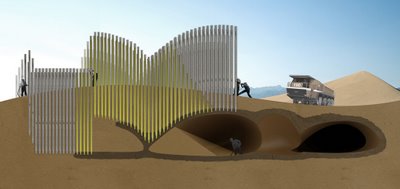He proposes to use a form of biological 3D printing to create a habitable “green wall” across the entire width of the Sahara desert in order to reduce the effects of desertification.
The concept is to use flexible containers filled with common bacteria that are capable of solidifying the ubiquitous sand into rigid sandstone. By applying this technique on a continuous basis over many years, Larsson believes it is indeed possible to achieve this lofty goal.
According to Larsson:
… made straight from the dunescape by flushing a particular bacteria through the loose sand… which causes a biological reaction whereby the sand turns into sandstone; the initial reactions are finished within 24 hours, though it would take about a week to saturate the sand enough to make the structure habitable.
I researched different types of construction methods involving pile systems and realised that injection piles could probably be used to get the bacteria down into the sand – a procedure that would be analogous to using an oversized 3D printer, solidifying parts of the dune as needed. The piles would be pushed through the dune surface and a first layer of bacteria spread out, solidifying an initial surface within the dune. They would then be pulled up, creating almost any conceivable (structurally sound) surface along their way, with the loose sand acting as a jig before being excavated to create the necessary voids. If we allow ourselves to dream, we could even fantasise about ways in which the wind could do a lot of this work for us: solidifying parts of the surface to force the grains of sand to align in certain patterns, certain shapes, having the wind blow out our voids, creating a structure that would change and change again over the course of a decade, a century, a millenium.
Via BldgBlog and the Holcim Foundation


